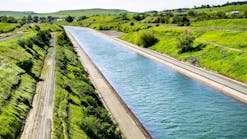Keeping Critical Water Infrastructure Safe and Resilient
About the author:
Albert Slap is president of Coastal Risk Consulting. Slap can be reached at [email protected].
As climate change impacts evolve, existing threats, such as sea level rise, storm surge and extreme rainfall and heat are expected to become more severe. Over the past 40 years, the number of natural disasters causing financial losses over $1 billion has risen steadily. Natural disaster insurance claims were the highest ever in 2017 at $144 billion, and most of the annual losses (a total of $337 billion) were uninsured. Wildfires in 2017 caused a record $21 billion in losses. The rapid sequence of hurricanes Harvey, Irma and Maria in the same year caused losses equivalent to 0.5% of the US GDP. Of the top ten costliest catastrophes ever recorded in the US, eight were hurricanes and four of the eight occurred in the past 8-years.
Many local governments are beginning to recognize this and are planning to adapt and increase their resilience with water infrastructure projects. For example, in 2019, the Florida DEP provided over $2 million in planning grants and financial assistance to 30 local governments aimed at preparing these coastal communities for current and future effects of rising sea levels, including coastal flooding, erosion and ecosystem changes. While this planning is taking place, however, most local governments have not fully considered nor taken action to mitigate the impacts of extreme weather and climate change on key water infrastructure facilities within their jurisdictions, including aging water infrastructure. These facilities, such as: water and sewer plants, storm water control systems, emergency operations centers, police and fire stations, public hospitals (and their parking lots), evacuation centers and transit are all critical for prompt, post-disaster recovery.
Local governments need to develop a disciplined, capital planning approach that fully considers the impacts of climate change on these important, publicly-owned water infrastructure facilities. Ultimately, this process will help local governments ensure that all public facilities are appropriately designed for future climate impacts.
Given limited budgets and staff in smaller to medium-sized local governments, the evaluation of critical water infrastructure facilities can start modestly. Coastal Risk’s building-specific, automated risk assessment system has been employed in a number of South Florida municipalities (including Village of Key Biscayne, Village of Miami Shores and Village of Bay Harbor Islands) to identify the most vulnerable assets using its Geographic Information System (GIS) and Light Detection and Ranging (LiDAR) data along with its cloud-based, algorithmic computations and modeling.
Using these state-of-the-art tools, Coastal Risk helps local governments determine which water infrastructure facilities will likely experience inundation by flooding from heavy rainfall, riverine sources, storm surges, or sea level rise and impacts from natural hazards and climate change impacts.
For existing assets that have already been built, potential adaptations are more complicated, as elevating the structure may not be an option. Making these critical assets safer and more resilient may require structural or mechanical modifications to existing buildings. This may also include the use of external and removable flood barrier systems. Some buildings may require the installation of watertight mechanical doors to reduce flooding in susceptible lower floors, which may hold key electrical equipment or servers that support emergency management operations.
Many of these remedial adaptation measures are cost-effective. As shown by recent tropical storms, the costs to repair and rebuild can be several orders of magnitude more expensive than preventing the damage by deploying protective measures in the first place. According to a recent report, “Natural Hazard Mitigation Saves”, published by the National Institute of Building Sciences, every dollar invested by the federal government in pre-disaster mitigation saves society $6 in post-disaster recovery costs. The report looked at more than 20 years of mitigation grants from federal sources, including the Federal Emergency Management Agency, the U.S. Department of Housing and Urban Development, and the U.S. Economic Development Administration.
To assess the cost-benefit of prevention measures, Coastal Risk uses a FEMA Hazus approach for individual buildings to estimate the “cost of doing nothing." These estimates include potential damage to building structures, contents and losses due to business interruptions. Once these estimates are developed, then a more direct comparison can be made between potential losses and the costs of risk mitigation. For critical water infrastructure facilities that may be existentially threatened by tidal flooding from sea level rise, the costs of retreat and relocation can also be calculated.
This type of planning and analysis for critical water infrastructure facilities may also allow local governments to better compete for federal and state funding programs, such as the FEMA Local Mitigation Strategy (LMS), Congressional funds, such as the HUD Community Development Block Grant DR-Disaster Relief (CDBGDR), and various other State programs.






